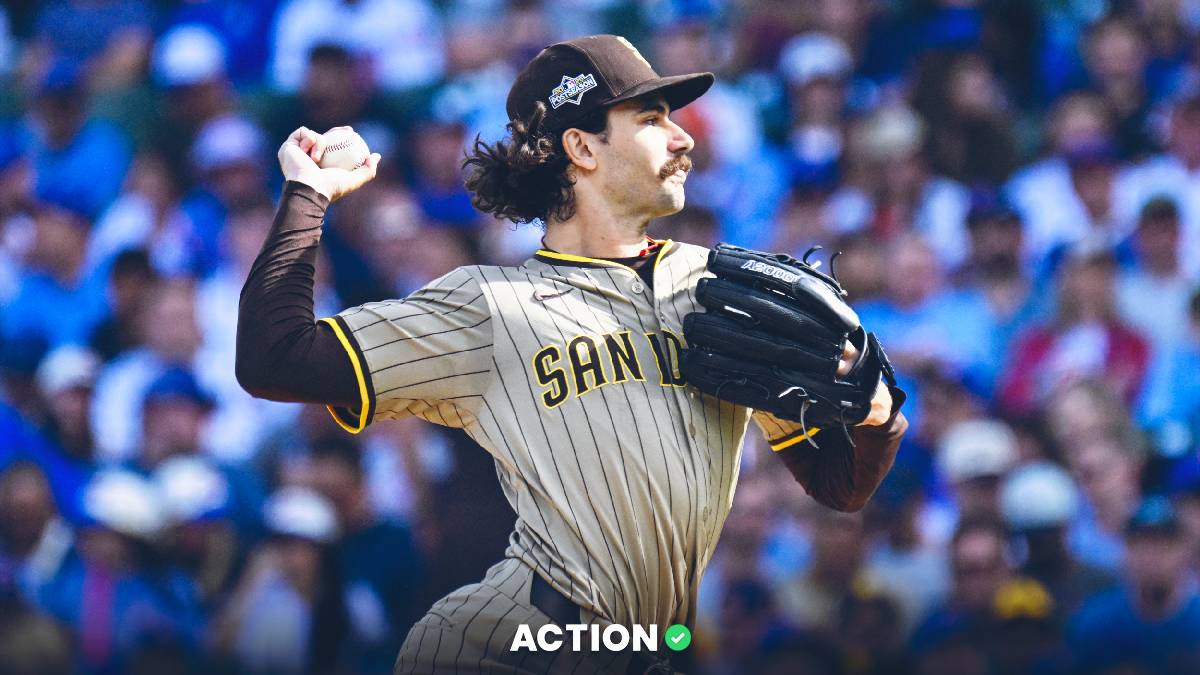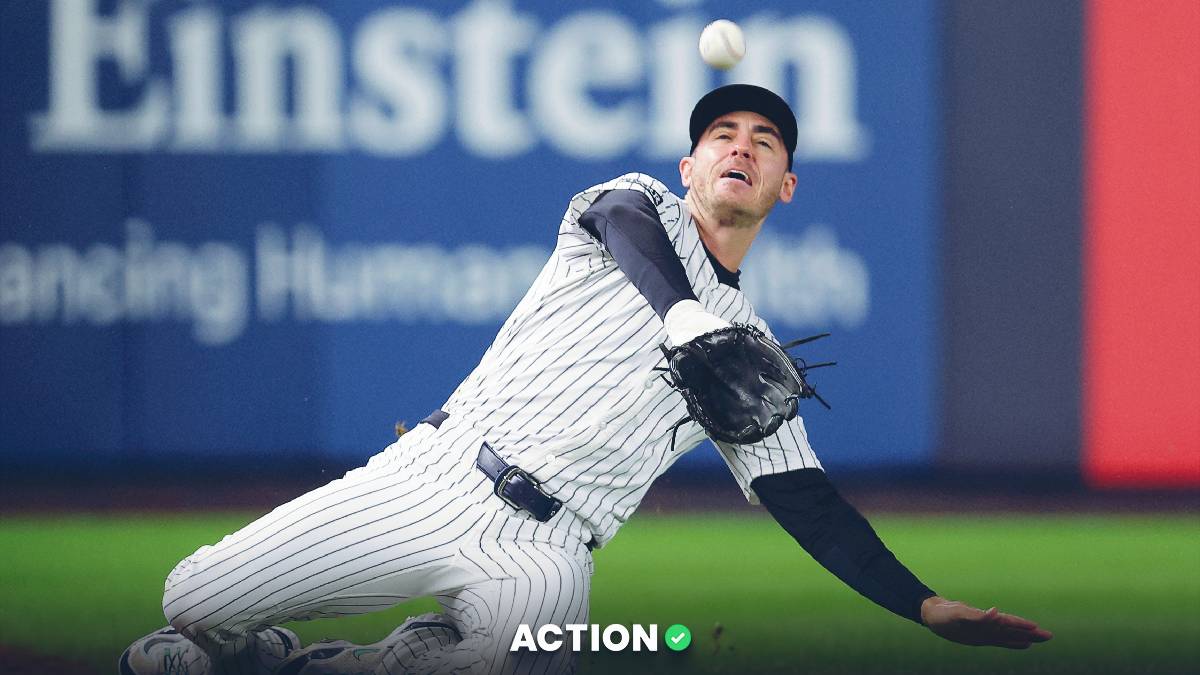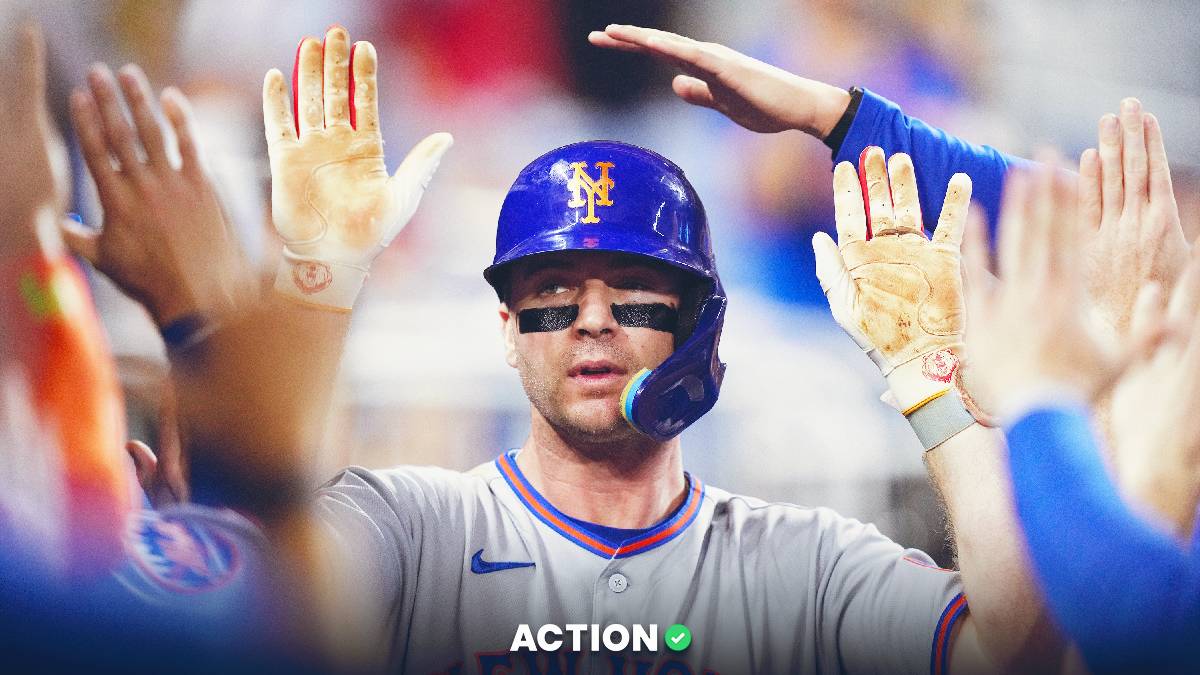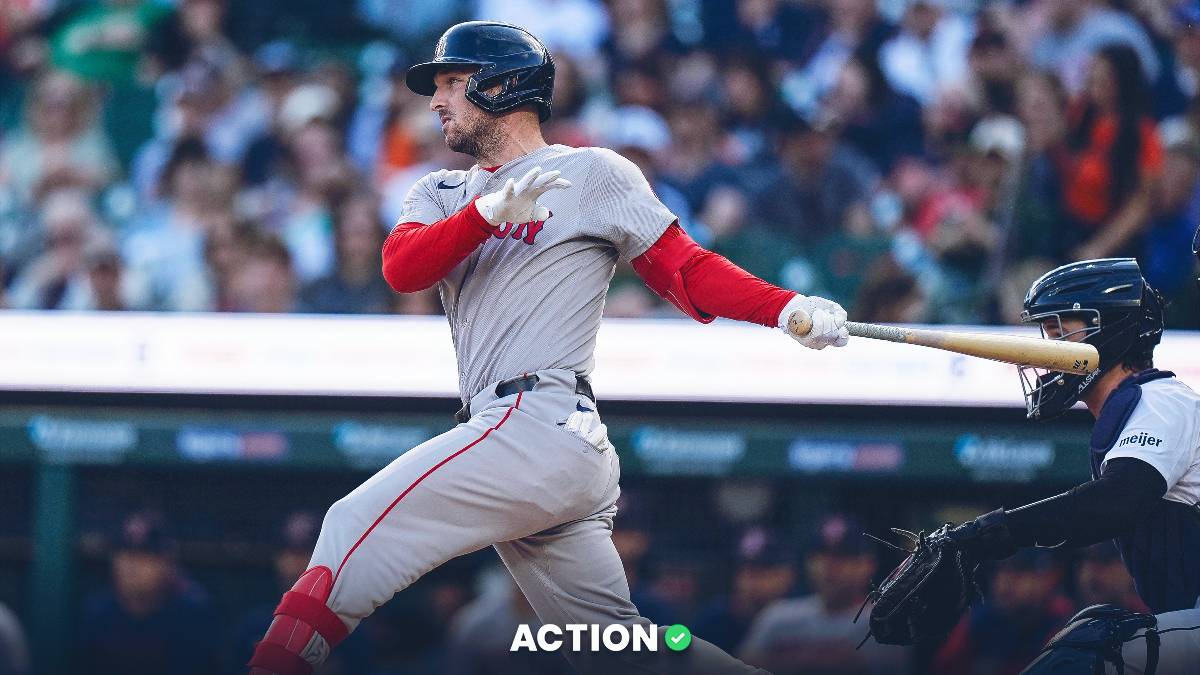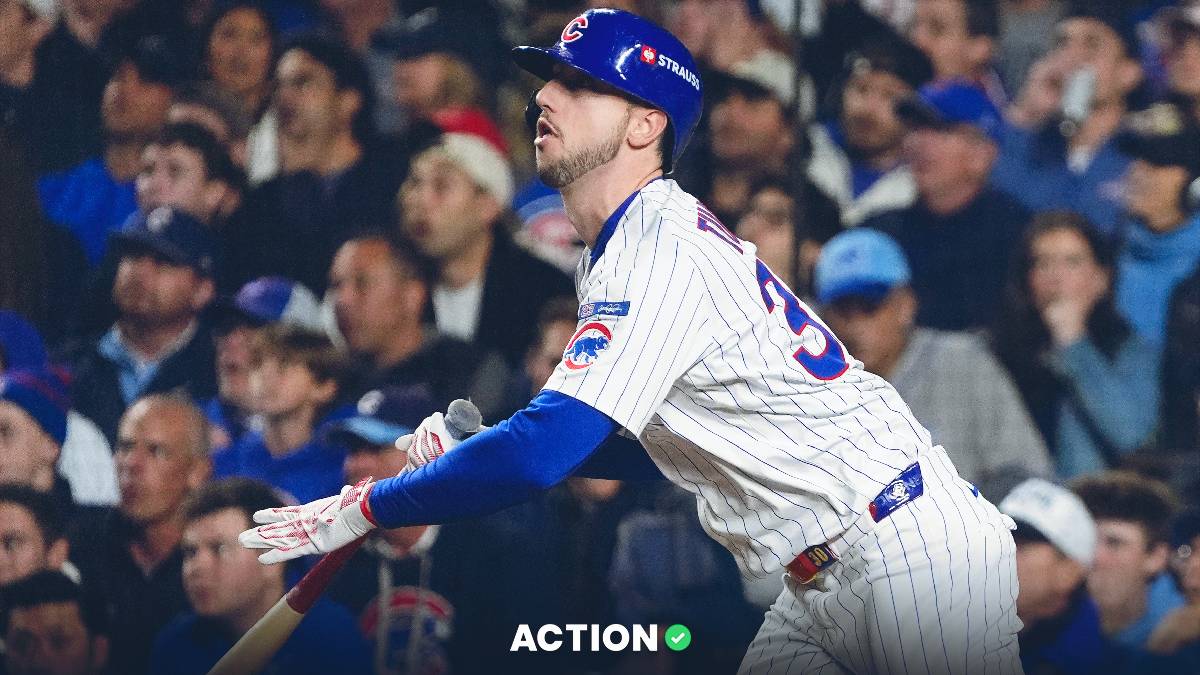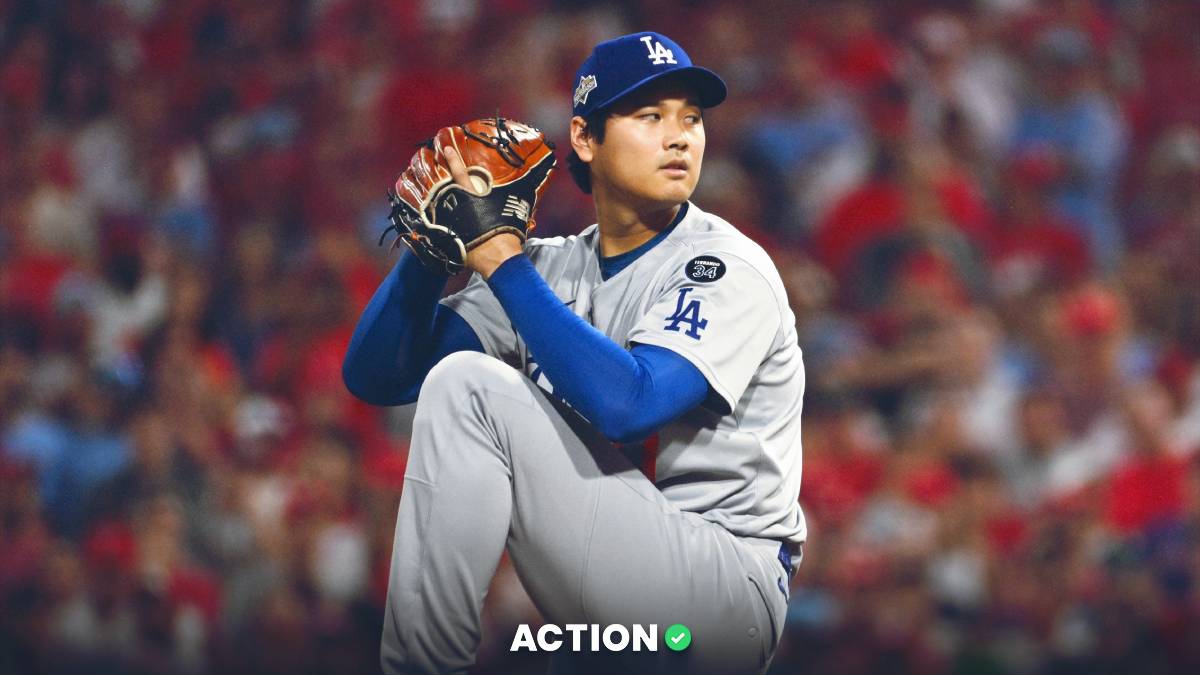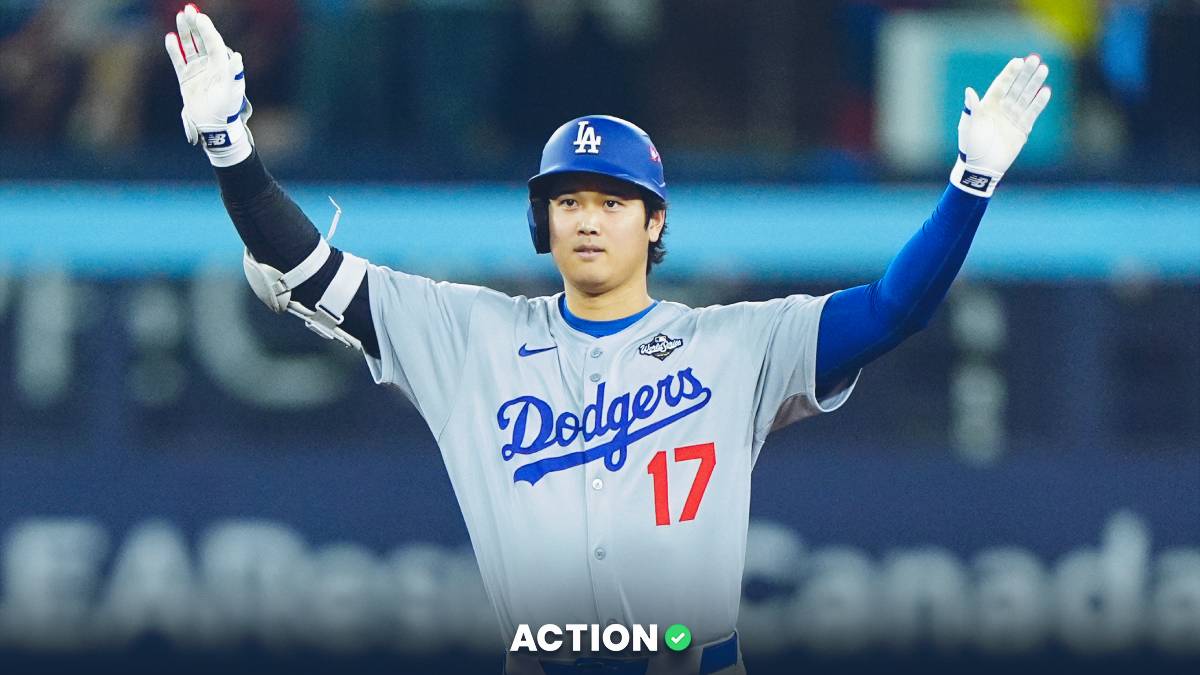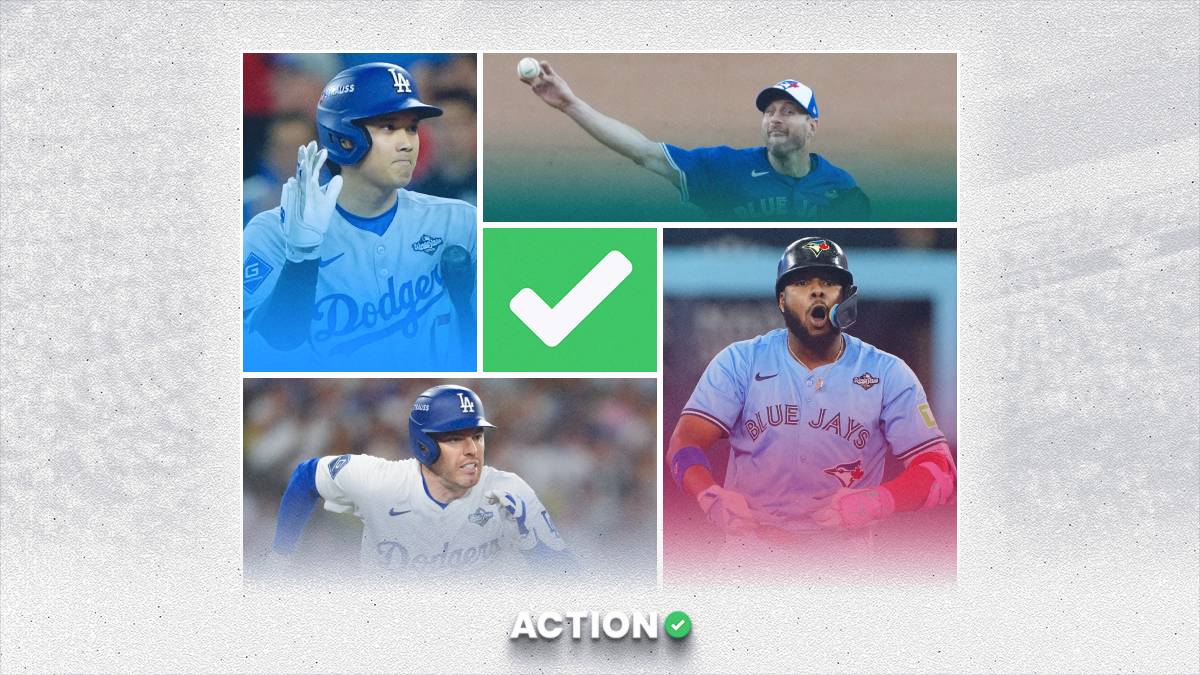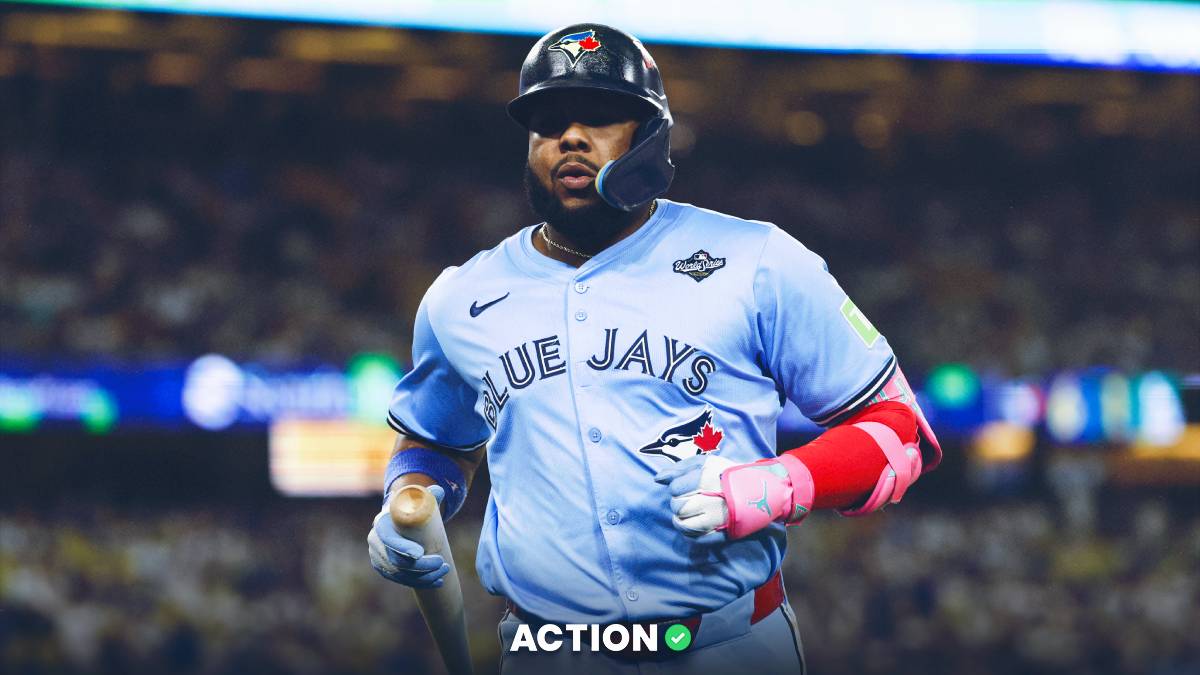Every two weeks during the MLB season, Action Network’s Tanner McGrath will compile a notebook of observations, analytical findings and actional information to help bettors find an edge in the daily grind of betting a 162-game season.
The hot topic in hitter analysis is SEAGER, a metric created by Baseball Prospectus’ Robert Orr.
SEAGER stands for Selective Aggression Engagement Rate. It was named after Corey Seager because he’s the most selective and aggressive hitter in the game.
It’s designed to “measure selective aggression on hittable pitches.” In other words, how often does a hitter swing – and swing aggressively – specifically at pitches he can crush? Doing so is the best way to simultaneously increase your power and plate discipline metrics, which is how the best hitters reach their peak.
Kyle Tucker and Rafael Devers are two hitters I’ve seen drastically improve their selective engagement. I broke down each profile in depth for Action Network and Pitcher List, respectively.
Without writing another couple thousand words on each player, I want to quickly summarize their improvements as an avenue to explain selective engagement more generally.
Tucker and Devers are laying off pitches more and drastically decreasing their zone-swing (Z-Swing%) and outside-zone (O-Swing%) swing rates. The most obvious result of swinging less is more walks, so both are on pace for career-high walk rates (Tucker 17.6%, Devers 12.2%) and OBPs (Tucker .392, Devers .376).
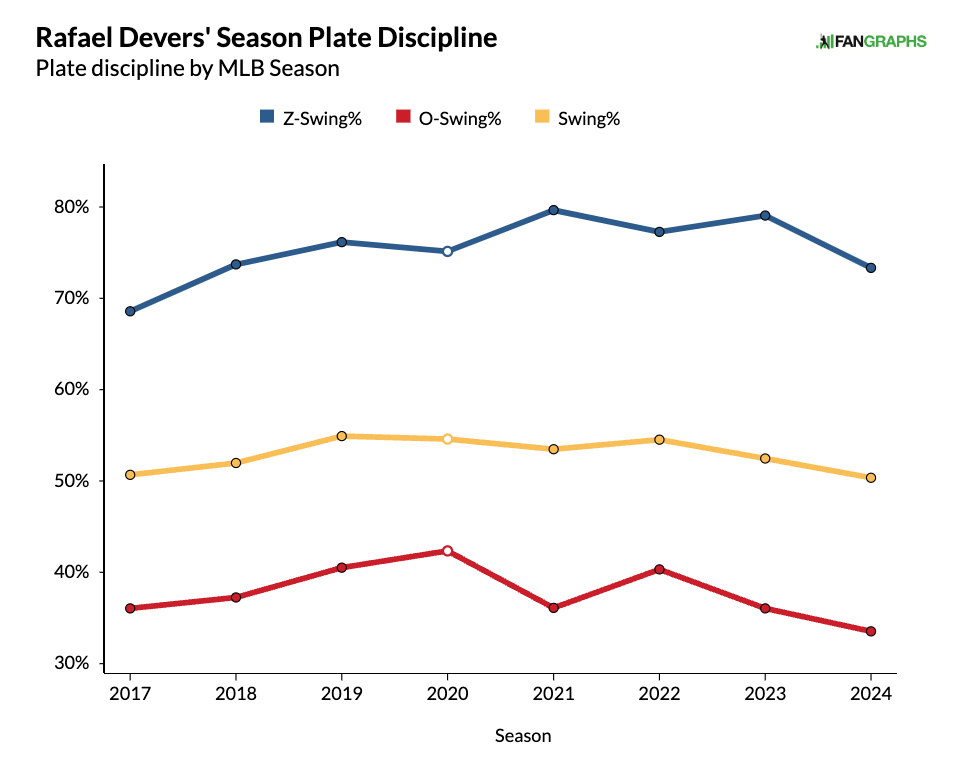
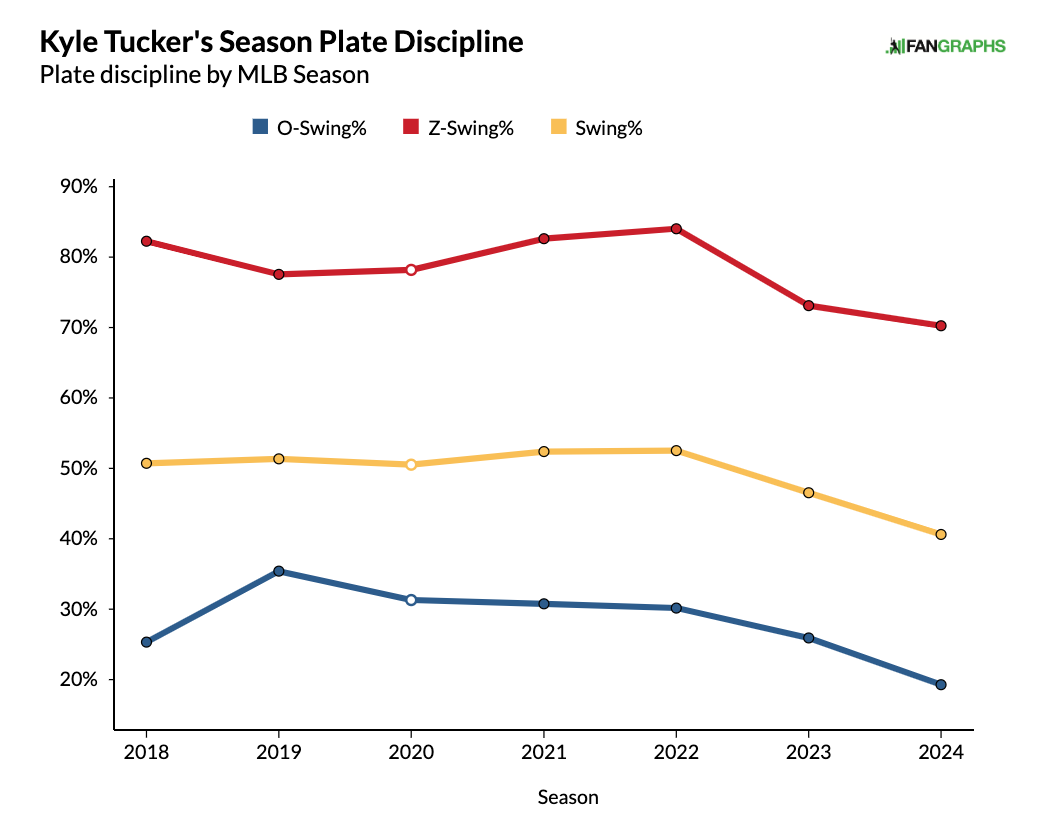
However, neither has sacrificed an ounce of power in their quest for more walks. In fact, each has seen a bump in power rates (ISO, barrel rate, etc.).
The reason why is selective engagement. The two are simply swinging less at pitches they can’t mash and swinging more at pitches they can.
For example, Tucker ranks eighth among MLB hitters in Swing/Take Run Value added (+22), while Devers ranks 37th (+9), with much of their value coming on Chase decisions – or decisions to not chase.


Once the metric becomes widely available, I fully expect SEAGER to be the most predictive metric for hitter and lineup projections in the future.
In the meantime, I would keep a close eye on new swing-decision metrics available across the league. It’s a good way of seeing – or potentially predicting – players and lineups that are making smart, selective power-discipline swing decisions.
A couple of resources include Pitcher List’s Hitter Ability Leaderboard and TJ Stats’ Decision Value App.
Here’s how Tucker and Devers stack up by Pitcher List’s Strikezone Judgement+ and Decision Value+ metrics.
| Player | SZ Judgement+ | Decision Value+ |
|---|---|---|
| Kyle Tucker | 132 | 133 |
| Rafael Devers | 101 | 91 |
And here are a few other hitters making smart decisions.
| Player | SZ Judgement+ | Decision Value+ |
|---|---|---|
| Aaron Judge | 124 | 128 |
| Gleyber Torres | 118 | 108 |
| William Contreras | 118 | 105 |
| Freddie Freeman | 116 | 104 |
| Juan Soto | 109 | 130 |
| Kyle Schwarber | 97 | 114 |
| Mookie Betts | 94 | 113 |
The Red Sox have been ravaged by injuries. Between Trevor Story, Triston Casas, Vaughn Grissom, Masataka Yoshida, Garrett Whitlock, Liam Hendriks and Lucas Giolito’s health issues, it’s incredible the Sox are only 3 1/2 games back in the AL Wild Card race entering Monday.
Much of the success has to do with Andrew Bailey and Justin Willard, the pitching coaches who have revamped Boston’s pitch mix and success. But injuries to star players leave the door open for youngsters to strut their stuff, and two Red Sox rookies aren’t getting enough respect for their efforts.
Among qualified rookies, Wilyer Abreu ranks second in fWAR (1.7), sixth in wRC+ (131), and fourth in OPS (.829). He’s hit the fifth-most homers (six), recorded the fifth-most RBIs (22) and smashed the most doubles (14).
He’s also been an effective right fielder, posting +2 Defensive Runs Saved (DRS) and +2 Outs Above Average (OAA) while sporting arguably the strongest arm of any right fielder (95 mph throws on average, 98th percentile).
He can be a little too free-swinging, but that’s fine for a younger player — look at how Raffy Devers has improved this season. What’s more important is Abreu's quick bat (75 mph average bat speed, 87th percentile) and barrel ability (12% barrel rate, 82nd percentile). The inputs are there, and better decisions should come with experience.
Meanwhile, Ceddanne Rafaela smacked two dingers and recorded five RBIs in Boston’s win over Detroit on Friday. Somehow, that isn’t the most RBIs he’s recorded in a game this year, as he managed seven against the Cubs back in April.
Rafaela is far more inconsistent than Abreu, mainly due to a hyper-aggressive approach at the plate, leading to high strikeout rates (27%) and low walk rates (4%). But Rafaela has been solid on the basepaths and has provided much-needed innings in the outfield and at short, often flashing the elite athleticism that makes him such an enticing prospect.
He’s not a rookie, but Jarren Duran leads the Sox in fWAR this year (1.9). Nobody is quicker on the basepaths (29.1 feet per second sprint speed, 93rd percentile), hence why he leads all qualified players in baserunning value (+2) and triples (eight) – Duran’s hit more triples than the Angels, Mariners, Marlins, Giants, Braves, Cardinals, Astros, Pirates, White Sox, Nationals and Mets.
While he’s not an elite or uber-consistent defensive outfielder, his speed means he can cover as much range as anyone (+5 Range OAA, 96th percentile).
Duran’s hitting fastballs better than ever this year, and he’s slightly improved upon his plate discipline metrics. Given his elite speed, he should continue to post above-average BABIPs (.337 this year), and he’s actually underperforming his expected wOBA (.346 expected vs .334 actual).
The Sox aren’t world-beaters. They’re 30-30 with a +22 run differential and a 98 wRC+. They’re excellent on the mound but rough in the field, so they’re about as close to a league-average team as they can get.
But the young outfielders are carrying the team. They’ve significantly improved Boston’s defensive metrics. They’re smashing the ball and showing versatility in every phase of the game. The Red Sox rank fourth among MLB teams in outfield fWAR this year (4.8).
Considering the injuries, the Red Sox season likely would’ve been over without these three.
Keep a close eye on the outfield at Fenway. You’ll have fun watching them.
The Yankees are arguably the best team in baseball.
They’re 42-19 with a +107 run differential, both marks lead the league. They’re on a five-game win streak, capping off the month of May with a 21-7 record.
They’re overwhelming right-handed pitching, posting a whopping 145 wRC+ against the side over the past month, a full 19 points higher than any other lineup during the stretch.
The Yanks don’t have a lefty-heavy lineup, with only three southpaw bats in the regular nine-man – of course, one of them is Juan Soto, who is slashing .318/.415/.624 against the side, suitable for a 1.039 OPS.
But New York’s superstar is shining against same-side pitching.
Aaron Judge has always had fairly even platoon splits, and he’s obliterating both sides this year. He’s looking to post his second 200-plus wRC+ season in the past three years. He leads all qualified hitters in fWAR (4.0), slugging (.658) and home runs (21).
That final point demands a bit more exploration.
Seventeen of his 21 dingers have come against right-handed pitchers — granted he’s only amassed 62 plate appearances against southpaws.
Judge’s barrel rate is approaching 30%, an obscene mark that’s nearly 10 points higher than any other qualified hitter.
| Player | Barrel Rate | Barrels |
|---|---|---|
| Aaron Judge | 29.6% | 45 |
| Juan Soto | 20.4% | 39 |
| Shohei Ohtani | 19.0% | 34 |
| Marcell Ozuna | 18.9% | 30 |
| Giancarlo Stanton | 18.8% | 25 |
| Oneil Cruz | 18.8% | 24 |
In the Statcast era (since 2015), only Judge has posted barrel rates north of 25% (2017, 2022, 2023). Aside from that, only Joey Gallo in 2018 (23%) and Shohei Ohtani in 2021 (22%) have come close.
Nobody can touch Judge in the barrel department. He’s posted a 28% barrel rate against right-handed pitching and a 37% rate against left-handed pitching.
FanDuel updated their 2024 MLB home-run odds leaderboard, and you now have to pay juice to back Judge in the market.
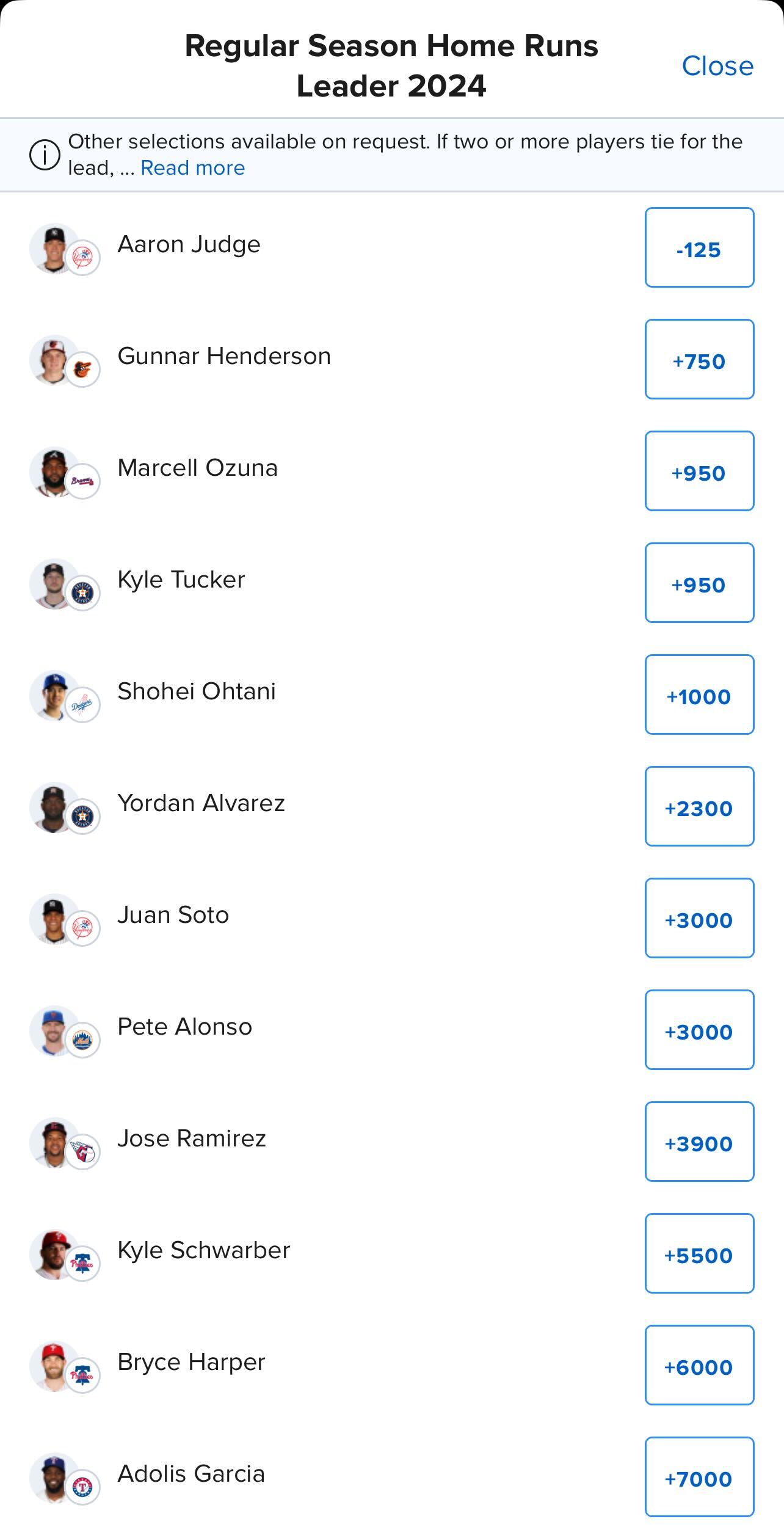
This is directly tied to his obscene barrel rate, as he projects to hit far more dingers than any other player. FanGraphs' on-pace leaderboard has him hitting 56, but that might be underselling it, considering he posted a 1.397 OPS with 30 barrels in May.
Are the Bronx Bombers overperforming? Surprisingly not, given their expected wOBA (.348) is about 10 points higher than their actual (.339).
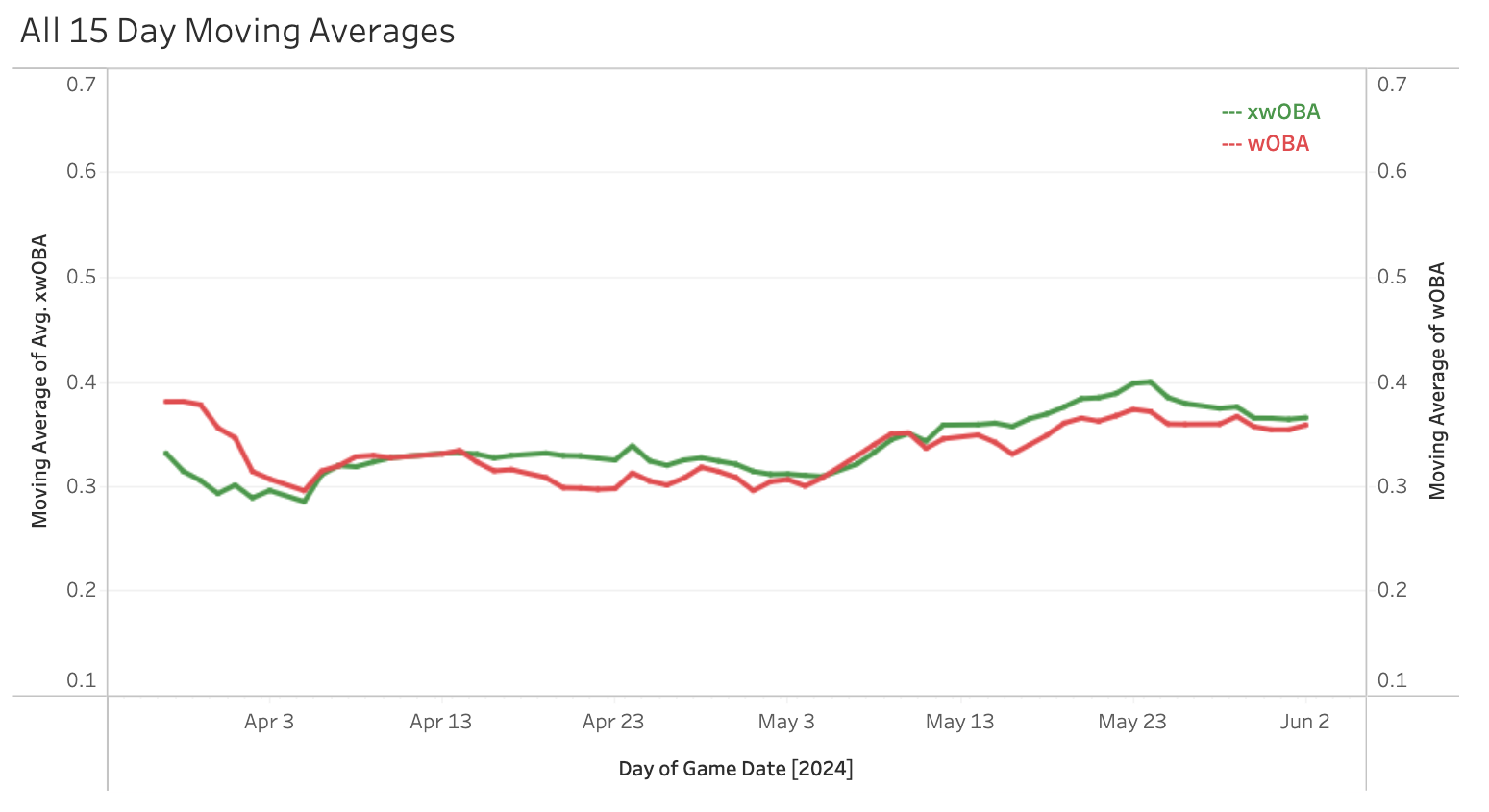
The Yankees could post historic offensive numbers this season, and they are a must-bet against right-handed pitching.
However, they’re a little vulnerable against lefties, ranking 12th among MLB lineups in wRC+ against left-handed pitching (105), including ninth over the past month (114). Many depth pieces are performing much worse against the left side, including lefties Alex Verdugo and Anthony Rizzo.
| Player | OPS vs RHP | OPS vs LHP |
|---|---|---|
| Aaron Judge | 1.062 | 1.095 |
| Juan Soto | 1.039 | 1.008 |
| Anthony Volpe | .827 | .674 |
| Gleyber Torres | .639 | .608 |
| Anthony Rizzo | .731 | .471 |
| Alex Verdugo | .791 | .692 |
| Giancarlo Stanton | .857 | .537 |
| Oswaldo Cabrera | .640 | .586 |
| Austin Wells | .591 | .481 |
I guess the moral of the story is: If you want to fade the Yanks, do it behind an opposing lefty. It's been the same thing with the Dodgers at times over the past few seasons.
Additionally, I think the Yankees bullpen is among the more overvalued units in the sport. The Yanks have a 2.87 reliever ERA, the second-best in baseball, but they pair that with a 4.09 reliever xFIP (20th). They’re only 17th in bullpen fWAR (1.1) and 20th in bullpen strikeout minus walk rate (12%). They rank fifth among bullpens in strand rate (75%).
Many of New York’s highest-leverage relievers are overperforming:
| Player | IP | ERA | xFIP |
|---|---|---|---|
| Clay Holmes | 26.1 | 1.37 | 2.87 |
| Luke Weaver | 35.2 | 2.78 | 3.32 |
| Ian Hamilton | 24.1 | 2.96 | 4.18 |
| Victor Gonzalez | 16.2 | 3.24 | 5.61 |
| Michael Tonkin | 15 | 1.20 | 4.09 |
| Ron Marianaccio | 12.2 | 1.42 | 4.09 |
They’ve started to regress, posting a 4.46 ERA over the past two weeks, which has resulted in two losses. They’re walking more batters (10%) and not forcing as many chases (30%).
While the Yankees are in Championship-or-Bust mode, I think they’re vulnerable in certain areas.
Not in the rotation, however, as Luis Gil, Nestor Cortes, Clarke Schmidt, Carlos Rodon, and Cody Poteet have stepped up in Gerrit Cole’s absence. I’ve been most impressed with Schmidt’s improvements, which stem mainly from his recently added cutter – the Yankees love teaching pitchers how to throw cutters.
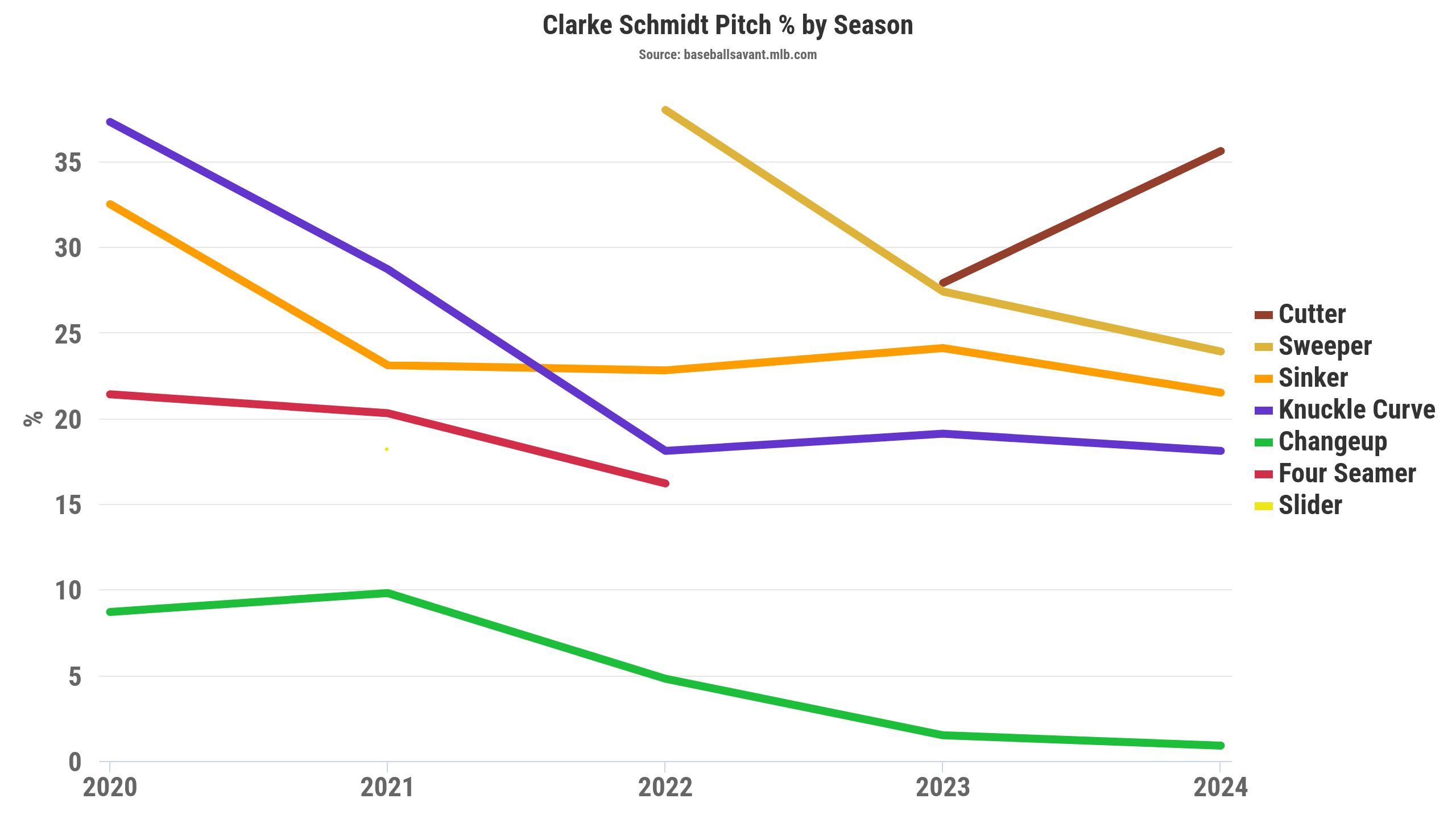
Imagine if the Yankees get Cole back.
Let’s do a little more reliever analysis.
The Reds have my new favorite bullpen. They rank fourth among relief units in fWAR (2.2) and sixth in strikeout minus walk rate (16%). They’ve posted a 2.03 ERA and 1.08 WHIP over the past two weeks behind a 25% strikeout rate.
Alexis Diaz and Buck Farmer have provided a generally good one-two punch. Throwing Nick Martinez and Brent Suter into the mix has added extra value. Lucas Sims has seen monstrous improvements in his advanced pitching model profile (132 Stuff+).
But the breakout star for Cincinnati this year is Fernando Cruz.
Cruz has faced 109 batters this year and struck out 50 of them. He leads qualified pitchers in whiff rate (44%) and ranks highly in chase rate (34%).
He doesn’t have an overwhelming fastball or cutter — but he doesn’t need them.
Cruz simply spams his splitter, throwing it 45% of the time. Hitters know it’s coming, but they’re still powerless against it, whiffing over 60% of the time.
It’s a funny pitch. With a spin rate under 900 RPM, it’s among the stillest offerings in the game. It comes in under 82 MPH on average. But the Stuff+ mark on it is well north of 150.
He throws it in the zone only 30% of the time and throws it over 60% of the time in two-strike counts. Opponents simply can’t get a read on it, constantly swinging over the top.
Of his 50 strikeouts, 44 have come on the splitter. He’s only allowed three hits on the pitch.
The Reds have a deep bullpen with one of the best high-leverage relievers in the game. I wish their lineup wasn’t so hapless.
I’ve always thought Miami’s bullpen was undervalued. The Fish were thought to have a borderline top-10 relief unit in the preseason, but disaster struck in April (4.77 ERA, 11% walk rate).
But since May 1st, the Marlins rank seventh in bullpen fWAR (1.1) and fourth in win probability added (2.6%). They also rank third in FanGraphs’ Clutch metric (1.15).
Tanner Scott hasn’t allowed a run during the stretch, lowering his season-long ERA to 1.57. Declan Cronin has evolved into an excellent middle-reliever (1.30 ERA and 28 strikeouts in 27 innings). A.J. Puk should continue to see better results now that he’s out of the rotation. Anthony Bender (5.40 ERA, 3.51 xFIP) and Andrew Nardi (5.48 ERA, 3.37 xFIP) are due for significant positive regression.
I really like this unit, and I believe they’ll perform even better going forward.
Throw in improved production from Jesus Luzardo and Ryan Weathers in the rotation, and the Marlins are trending up. They went 14-13 in May.
I expect positive regression for starters Braxton Garrett (4.56 ERA, 3.38 xFIP) and Edward Cabrera (7.17 ERA, 3.46 xFIP) – although the latter is on the IL – two of the more promising young arms in the National League.
I'm looking to buy the Fish when possible. The market is undervaluing their run-prevention unit.
On the contrary, I’m fading the Royals bullpen.
Kansas City’s relievers were vastly overperforming in the early going, posting a 3.44 ERA through April despite a 4.73 xFIP, mainly due to MLB’s third-highest bullpen strand rate during the month (78%).
A unit dependent upon James McArthur and John Schrieber was never going to be elite. They’ve finally seen some regression, with Royal relievers posting a 5.82 ERA, 4.90 SIERA and 1.66 WHIP over the past two weeks behind an obscenely poor 4% strikeout minus walk rate. They now rank last in bullpen xFIP (4.70) and Stuff+ (94).
Things could get worse for Kansas City, especially considering every starting pitcher — except Cole Ragans — is overperforming.
| Player | IP | ERA | xFIP |
|---|---|---|---|
| Seth Lugo | 78.1 | 1.72 | 3.85 |
| Michael Wacha | 68 | 4.24 | 4.13 |
| Brady Singer | 61.2 | 2.63 | 3.32 |
| Alec Marsh | 55 | 3.76 | 4.26 |
The Royals have amassed the second-most fWAR of any rotation (7.0), trailing only the dominant Phillies (8.0). But I just can't see Lugo, Wacha, Singer and Marsh sustaining their production.
The 36-25 Royals might be in for a rough stretch soon. Keep that in mind.
Tanner Houck currently sits with the third-shortest odds to win the AL Cy Young (+1200, FanDuel). Chris Sale currently sits with the fourth-shortest odds to win the NL Cy Young (+1200, FanDuel).
You could argue they both should be the favorites.
Houck leads all MLB pitchers in fWAR this year, a whopping 2.7 wins that’s a full 0.3 ahead of the second-best arm (Ragans). He's posted a 1.85 ERA through his first 12 outings, even posting a Maddux aginst Cleveland (shutout on 94 pitches).
Sale posted a 0.56 ERA across 32 innings in May, striking out 45 batters with only two walks across five dominant outings. Unfortunately, he backed that up with an eight-run outing across four innings against the A’s on Sunday — funny how baseball works sometimes.
These two are scarily similar. Both rely heavily on sliders with huge horizontal breaking action. Both mix in plenty of sinkers against platoon bats. Houck uses a splitter as his big putaway pitch, while Sale uses a changeup.
The scariest part? They even look the same on the mound.
Houck is legitimately a mirror-imaged Sale. It makes me wonder how much Houck learned from Sale during their time together in Boston. It also makes me wonder what kind of wizardry Andrew Bailey could’ve pulled if the Sox hadn’t traded Sale.
These are two must-watch, play-on pitchers for the remainder of the season. Both could win the Cy.









